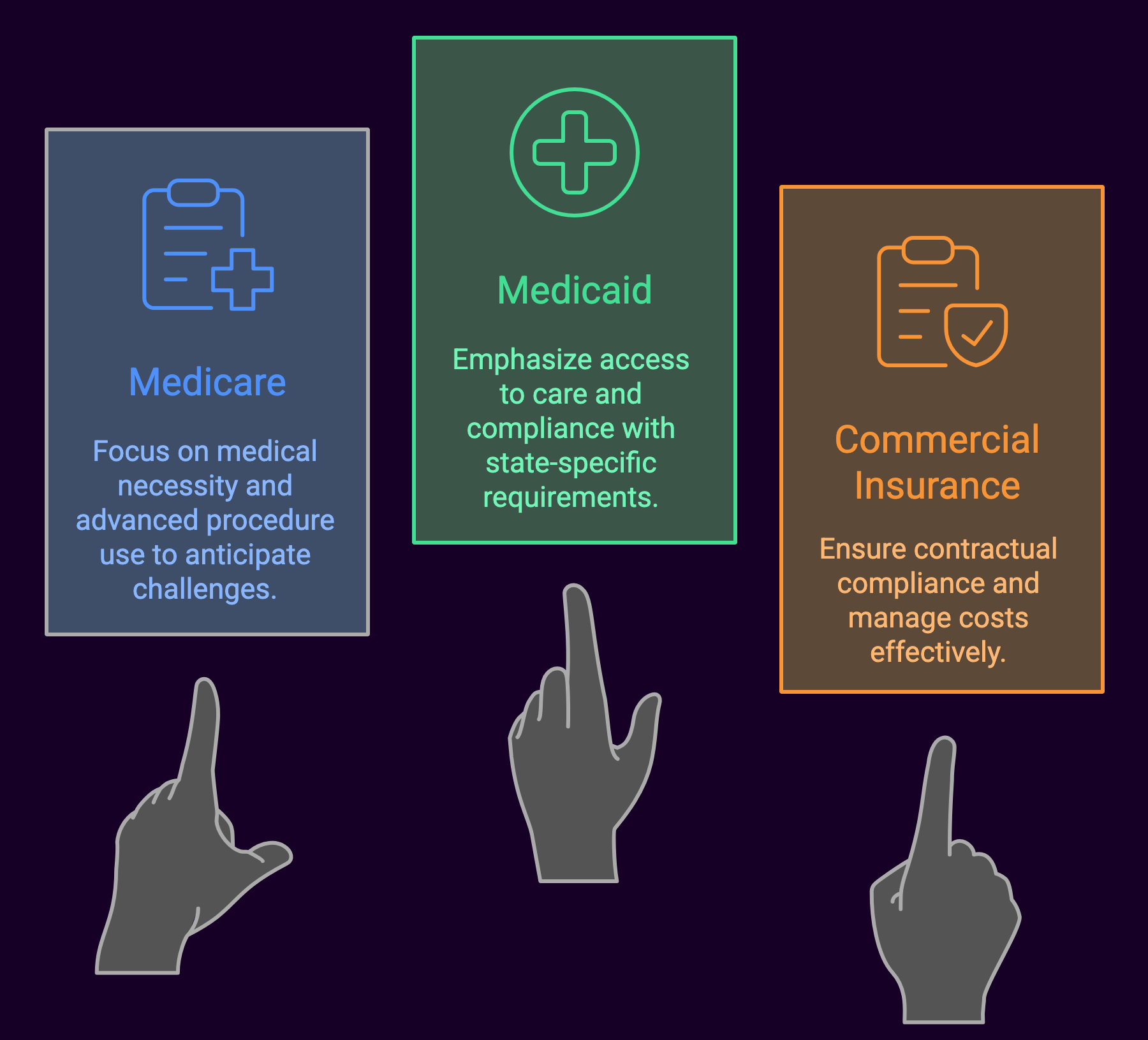Healthcare providers face an increasingly difficult audit terrain from various payers, including Medicare, Medicaid, and commercial insurance companies. These audits can feel overwhelming, but with proper preparation and understanding of the process, medical practices can navigate them successfully while maintaining compliance and protecting their revenue streams.
The audit process has shifted significantly over the past decade, becoming more sophisticated and frequent as payers seek to control costs and ensure appropriate utilization of healthcare services. Knowing what triggers these audits, how to respond effectively, and what preventive measures to implement can make the difference between a smooth resolution and a prolonged, costly ordeal.
The Audit Terrain
 Payer audits serve multiple purposes beyond simple compliance checking. They help identify patterns of potential fraud, waste, and abuse while ensuring that healthcare services meet established medical necessity criteria. Medicare Recovery Audit Contractors (RACs), Medicaid Integrity Contractors (MICs), and commercial insurance audit teams each operate under different guidelines and priorities, but they share common goals of cost containment and quality assurance.
Payer audits serve multiple purposes beyond simple compliance checking. They help identify patterns of potential fraud, waste, and abuse while ensuring that healthcare services meet established medical necessity criteria. Medicare Recovery Audit Contractors (RACs), Medicaid Integrity Contractors (MICs), and commercial insurance audit teams each operate under different guidelines and priorities, but they share common goals of cost containment and quality assurance.
The shift toward value-based care has intensified audit activity, as payers scrutinize not just the appropriateness of individual services but also overall treatment patterns and outcomes. This means providers must be prepared to defend not only specific procedures or diagnoses but also their broader care management strategies.
Modern audit programs utilize sophisticated data analytics to identify potential issues before conducting manual reviews. These systems flag unusual billing patterns, outlier providers, and services that don’t align with typical treatment protocols. Understanding these technological approaches helps providers anticipate potential audit triggers and address them proactively.
Common Audit Triggers and Red Flags
Certain factors consistently attract audit attention across all payer types. High-volume billing for specific procedures, especially those with significant reimbursement rates, often triggers automated reviews. Providers who bill substantially above peer averages or show sudden increases in specific service categories may find themselves subject to closer scrutiny.
Documentation inconsistencies represent another major trigger. When clinical notes don’t support the level of service billed, or when there are gaps in the medical record that make it difficult to establish medical necessity, auditors take notice. This includes scenarios where the complexity of the patient’s condition doesn’t align with the services provided or where treatment patterns seem inconsistent with standard care protocols.
Regional billing discrepancies can trigger scrutiny. Practices charging substantially higher or lower rates than nearby providers may face audits, particularly when accompanied by atypical referral networks or financial relationships with other medical facilities.
Preparing Your Practice for Audits

Effective audit preparation begins long before any audit notice arrives. Establishing robust internal audit processes creates a foundation for successful responses to external reviews. This means regularly reviewing billing practices, ensuring documentation standards are consistently met, and maintaining organized, easily accessible medical records.
Staff training plays a crucial role in audit preparedness. Everyone involved in patient care, documentation, and billing should understand the importance of accurate, timely record-keeping. This includes clinical staff who must document thoroughly and administrative staff who handle coding and billing processes.
Technology infrastructure also supports audit readiness. Electronic health record systems should be optimized for easy retrieval of patient information, and billing systems should maintain clear audit trails that demonstrate the rationale behind coding decisions. Regular system backups and data integrity checks ensure that information remains accessible and accurate when needed for audit responses.
The Audit Response Process
When an audit notice arrives, the immediate response sets the tone for the entire process. Quick acknowledgment of receipt and careful review of the audit parameters demonstrate professionalism and cooperation. Knowing exactly what records are being requested, the timeframe for response, and the specific criteria being evaluated helps focus the response effort effectively.
Assembling the right team for audit response is critical. This typically includes clinical leadership who can speak to medical necessity decisions, coding and billing specialists who understand the technical requirements, and administrative staff who can coordinate record retrieval and submission. Having legal counsel available for consultation can also be valuable, particularly for complex cases or when significant financial exposure exists.
Organization and presentation of requested materials can significantly impact audit outcomes. Providing clear, well-organized responses with supporting documentation makes the auditor’s job easier and demonstrates the practice’s commitment to compliance. This includes creating cover letters that explain the organization of submitted materials and highlight key supporting evidence.
Documentation Excellence as Audit Defense

Strong documentation serves as the primary defense against audit challenges. Clinical notes must clearly establish the medical necessity for services provided, including the patient’s presenting symptoms, clinical findings, treatment decisions, and response to interventions. Documentation should tell a coherent story that supports the level of service billed.
Timeliness of documentation matters significantly in audit situations. Notes completed contemporaneously with patient encounters carry more weight than those created after the fact. When late entries are necessary, they should be clearly identified as such and include explanations for the delay.
Specificity in documentation helps auditors understand the complexity of patient cases. Vague or template-driven notes that don’t reflect the unique aspects of each patient encounter are more likely to be challenged. Including relevant negative findings, detailed physical examination results, and clear reasoning for treatment decisions strengthens the audit defense.
Managing Different Payer Requirements

Each payer type brings unique audit characteristics and requirements:
- Medicare audits often focus heavily on medical necessity and appropriate use of advanced procedures or technologies. Medicare coverage policies and local coverage determinations help providers anticipate potential challenges and ensure their documentation addresses relevant criteria.
- Medicaid audits frequently emphasize access to care and appropriate utilization of services, particularly for vulnerable populations. These audits may scrutinize referral patterns, coordination of care, and compliance with state-specific requirements that vary significantly across jurisdictions.
- Commercial insurance audits tend to focus on contractual compliance and cost containment. These payers may challenge services that exceed their internal utilization guidelines or question the appropriateness of high-cost interventions. Understanding specific contract terms and utilization management criteria helps providers respond effectively to these challenges.
Financial Impact and Revenue Protection
 Audit outcomes can have significant financial implications beyond the immediate claim adjustments. Extrapolation methodologies used by some auditors can result in substantial repayment demands based on error rates found in small sample sizes. Understanding how these calculations work and when they can be challenged is crucial for protecting practice revenue.
Audit outcomes can have significant financial implications beyond the immediate claim adjustments. Extrapolation methodologies used by some auditors can result in substantial repayment demands based on error rates found in small sample sizes. Understanding how these calculations work and when they can be challenged is crucial for protecting practice revenue.
The appeals process offers opportunities to overturn adverse audit findings, but it requires strategic thinking and thorough preparation. Each level of appeal has specific requirements and timeframes that must be met to preserve appeal rights. Developing relationships with qualified appeal specialists or legal counsel experienced in healthcare audit appeals can be valuable for complex cases.
Cash flow management during audit processes requires careful planning. Some audits result in temporary holds on payments or requests for immediate repayment of questioned amounts. Having financial reserves or access to credit facilities helps practices maintain operations while audit issues are resolved.
Building Long-Term Compliance Programs
Sustainable audit success requires moving beyond reactive responses to proactive compliance management. This means implementing ongoing internal monitoring programs that identify potential issues before external auditors discover them. Regular internal audits of coding accuracy, documentation quality, and billing practices help maintain consistent compliance standards.
Staying current with regulatory changes and payer policy updates is essential for maintaining compliance over time. This includes monitoring Medicare transmittals, Medicaid bulletins, and commercial payer communications that announce policy changes or new coverage criteria.
Continuous education for all staff members involved in patient care and billing ensures that compliance knowledge remains current and consistent throughout the organization. This includes regular training updates, policy review sessions, and feedback mechanisms that help identify and address compliance concerns quickly.
Technology and Data Analytics in Audit Management

Modern practices can leverage technology to improve their audit readiness and response capabilities. Data analytics tools can help identify internal patterns that might trigger external audits, allowing for proactive corrections before issues are discovered by payers.
Electronic health record optimization includes ensuring that templates and documentation tools support all-inclusive, audit-ready clinical notes. This means customizing systems to prompt for necessary information and creating workflows that support thorough documentation without creating excessive administrative burden.
Summary: Provider Payer Audit Management
 Audit tracking systems help practices manage multiple concurrent audits and ensure that deadlines are met and requirements are fulfilled completely. These systems can also maintain historical audit information that helps identify trends and improve future performance.
Audit tracking systems help practices manage multiple concurrent audits and ensure that deadlines are met and requirements are fulfilled completely. These systems can also maintain historical audit information that helps identify trends and improve future performance.
Successfully managing healthcare payer audits requires a detailed approach that combines strong foundational practices with strategic response capabilities. Knowledge of the audit landscape, preparing thoroughly, and maintaining ongoing compliance programs enables healthcare providers to navigate these challenges while protecting their practices and continuing to provide quality patient care. The investment in proper audit management pays dividends not only in successful audit outcomes but also in overall practice efficiency and compliance culture that benefits all stakeholders.
Contact us to assist with payer audit needs and/or challenges.

